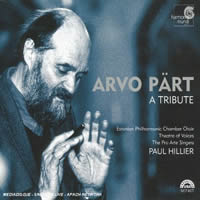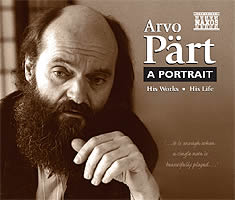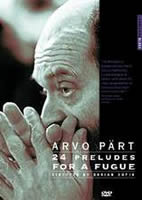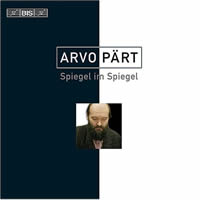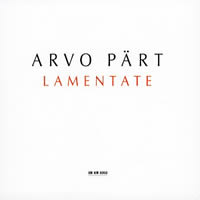Pärt at 70
|
Grant Chu Covell [November 2005.] I had thought to spin yarns for Boulez’s 80th birthday (March 26, 2005). The onetime enfant terrible still stands tall in my book despite his uncharacteristic mellowing and much-reduced production. In deference to timeliness, let’s look at Arvo Pärt on his 70th (September 11, 2005). Compared to Boulez, Pärt stands as a compelling antipode. It was the multi-cello version of Fratres (1983) which alerted me to Pärt’s simple tonal phrases unhurriedly repeated over magical pedal points. Having been schooled on Mahler, Strauss and Berg’s high Romanticism, I heard the Estonian’s brazen simplicity as having cleansed the stables. Pärt bundled white notes in ersatz medieval clothes, blinding all comers with his spirituality. I enjoy hearing a comforting cadence now and again. I’m indifferent to the composer’s religiosity, an attitude on my part that probably flies in the face of his adherents. Pärt’s output divides into three periods. The first culminates in an experimental blending of serialism and collage, best explored on BIS 434. An appropriately cabalistic 1963 Perpetuum Mobile is dedicated to Nono. The 1966 Second Symphony’s scattered pizzicato opening dissolves in bird calls, and the same year’s cello concerto, “Pro et Contra,” unites tonal flourishes and aleatoric splashing. Its central movement mimics the cadence that bridges Brandenburg Concerto No. 3’s movements. In retrospect, we can attribute these works to the political aspects of boisterous juvenile squandering. Pärt entered a silent chasm between ’68 and ’76. Like a burp, only the Third Symphony (1971, dedicated to Neeme Järvi) escaped. Frankly, I’m surprised Pärt hasn’t yanked this potpourri of romantically orchestrated Landini cadences from his catalog. As authentic as Respighi’s Ancient Airs and Dances, the symphony stampedes across Rochberg and Silvestrov ground. In 1976 the veil lifted, and Pärt entered his second period, dominated by his hallmark tintinnabuli style. These are the works that established Pärt as not just another disillusioned Eastern-European voice. The third period’s start is harder to nail, though it commenced around 1997. Tintinnabuli’s crutches are cast aside, and tuneful wide-eyed innocence yields to sobriety. Some compositions are heavy with grief and weariness, dark tonality infused with post-Romantic flavors. Orchestral works have a Webernian or late-Stravinsky palette. Not every recent piece breaks with the past. The countertenor and organ of My Heart’s in the Highlands (2000) could have been envisioned in the 1980s. One middle-period Pärt CD is indispensable whether you favor Ferneyhough, Rorem, Machaut or Monteverdi. In 1984, ECM inaugurated its New Series line with Tabula Rasa, containing Cantus in memoriam Benjamin Britten (1977/80), Tabula Rasa (1977) and two perfect versions of Fratres. Gidon Kremer and Keith Jarrett own the 1980 violin / piano Fratres, despite Gil Shaham’s recent mildly aggressive endeavor on DG 289 457 647-2. Like oil splattering on a hot skillet, Kremer’s spiky arpeggios suggest Glass’ contemporaneous Einstein. Even when awash with spirituality, Pärt never leaves classic minimalism far behind, the 2000 Cecilia, vergine romana’s ending a case in point. The Berlin Philharmonic’s 12 cellists offer a lush cello-orchestra Fratres (1983), though I pity the back desk, which has to bow open strings for the full duration. Tabula Rasa prunes Vivaldian progressions and textures, adding a prepared piano for a Cage-in-the-monastery feel. Alfred Schnittke took to the keyboard for the premiere and he’s captured here. It’s the string orchestra’s calming modal tune which announces Pärt’s true arrival. Of course, the same homely vocabulary peeps out in the British string orchestra tradition. (I wonder if Bryars took away any lessons from this disc.) For the truly obsessed, ensemble I Fiamminghi’s six versions of Fratres smother Telarc CD 80387. I won’t enumerate the combinations. Suffice to say that only fanatics could endure half a dozen renditions. (Pärt’s publisher indicates 12 official arrangements, including trombone over string orchestra and percussion, and guitar with strings and percussion.) The other three non-repeated compositions flaunt the tintinnabuli technique. (Why not a Fratres remix album?) ECM’s Tabula Rasa is quite enough, despite Kremer’s recent replay of said title piece on Silencio (Nonesuch 79582-2). Sometimes Pärt’s simplicity pains, especially when performer pensiveness slumps into bathos. Like an X-ray, Alina (ECM 1591) exposes the skeleton’s fragile bones. Spiegel im Spiegel (1978) and Für Alina (1976) are the disc’s only compositions, the latter played twice, the former (surrounding it) thrice. Für Alina, the very first tintinnabuli piece, positions the pianist’s hands wide apart, creating a bell-like resonance over a single struck octave with sustaining pedal down. Ignoring the call to an aching mysticism and thirst for reflection, I enjoy the ringing piano and plainsong-like curves. These recordings of Spiegel im Spiegel suffer because the solo string player (violin first and third time, cello second) never quite meshes with the keyboard. The piano line, à la the C-major prelude from Bach’s WTC I, sounds like an exercise; the soloist becomes marooned in Czerny-land. This fall, five labels celebrate septuagenarian Pärt, each in their own way. I save the best for last.
“Arvo Pärt: A Tribute.” Arvo PÄRT: Dopo la vittoria (1996/98); The woman with the alabaster box (1997); Berliner Messe (1990/97); Solfeggio (1964); Magnificat (1989); Bogoróditse Djévo (1990); I Am the True Vine (1996); Which was the son of… (2000). Estonian Philharmonic Chamber Choir; Theatre of Voices; Pro Arte Singers; Christopher Bowers-Broadbent (organ); Paul Hillier (cond.). Harmonia Mundi 907407 (http://www.harmoniamundi.com/). Emphasizing Pärt’s vocal music, this disc celebrates Hillier almost as much as it does the composer. The chorus master joined Pärt’s fan club early, participating in premieres and recordings, thus spreading the Estonian composer’s music throughout the West. “The initial attraction was essentially visual: the notation had the appearance of having been refracted through medieval music [ … ] There was almost nothing there [ … ] but from my experiences with medieval music, I knew that therefore everything might be there,” wrote Hillier in the scholarly and comprehensive volume, Arvo Pärt (Oxford University Press, 1977). An a cappella collection implies variety, but Harmonia Mundi’s slightly awkward compilation might prove bewildering. Dopo la vittoria is freshly recorded. Other pieces are reprints, a majority recycled from HMU 907242. While one doesn’t have to be a Lutheran to enjoy a Bach cantata, many of Pärt’s overtly sacred works leave me cold (the 1995/97 Kanon Pokajanen on ECM 1654 remains inscrutable). Hiller holds up Passio Domini Nostri Jesu Christi Secundum Joannem (1982) as Pärt’s masterpiece (ECM 1370), noting how drama and design powerfully meld. I find the message impeding the music. The 1985 Te Deum (ECM 1505) successfully balances light and dark. The Berliner Messe’s gently lilting Credo is especially wonderful. For this tribute, Harmonia Mundi and Hillier opt for the thin four-voices-plus-organ arrangement instead of the grander chorus and strings version (also on ECM 1505). “De Profundis” (Harmonia Mundi 907182) may be the better disc owing in part to the title piece’s gravity. The post-1990 works presented here absorb many stylistic shifts, suggesting, perhaps unfairly, that popularity resulted in rushed commissions. Curiously, Pärt completed a scant handful of works between ’91 and ’96, suddenly erupting in ’97 with several major compositions reflecting a stylistic evolution. Sung in Italian, Dopo la vittoria’s 11 minutes blend different moods to illustrate Saint Ambrose’s creation of the Te Deum hymn. In English, The woman with the alabaster box, Magnificat, and I Am the True Vine lose their individuality. Perhaps Hillier tackles them too briskly. The folksy miniature Bogoróditse Djévo and sections of Dopo la vittoria reveal a relaxed, colloquial mood. Which was the son of… sets repetitive genealogical tables, a compositional exercise in allaying boredom. Reaching back to Pärt’s bad-boy serial days, Solfeggio layers just the piano’s white notes, sustaining pitches to create dissonance.
“Arvo Pärt: A Portrait.” Für Alina (1976); Cantus in memoriam Benjamin Britten (1977); Fratres (1997); Magnificat (1989); Summa (1977); The Beatitudes (1990); Annum per annum (1980); Collage über B-A-C-H (1964); Pro et Contra for cello and orchestra (1966); Cantate Domino canticum novum (1977); Spiegel im Spiegel (1978); Triodion (1998); excerpts from Symphony No. 1 (1963), Symphony No. 3 (1971), Tabula Rasa (1977), Passio (1982) and Berliner Messe (1990). Var. performers. Naxos 8.558182-83 (http://www.naxos.com/). This release attempts to educate. Drawing upon the BIS, Claudio Records, Nimbus and its own catalog, Naxos assembles a comprehensive two-disc set containing excerpts and key works from Pärt’s first two periods, hinting at the third’s depth. For those who can’t track down Hillier’s tome, Nick Kimberley’s thoughtful essay provides a valuable context. A quibble: The track listing doesn’t indicate corresponding essay pages, forcing the reader to hunt through the booklet to find the relevant discussion. Still, this is an excellent introduction. The two discs do not unfold chronologically, and orphaned excerpts from large works (Passio, Berliner Messe) are not contiguous. The first four tracks tell a good story. Pianist Alexei Lubimov leads with the tintinnabuli exemplar, Für Alina, taken at a direct pace. Then follows the second movement from Pärt’s rambunctiously avant-garde 1966 Second Symphony. Third up is the lush tintinnabuli Cantus in memoriam Benjamin Britten, and then a cut from the choral Passio. Annum per annum (1980) has always stood out. Naxos’ tracking of Kevin Bowyer’s performance (borrowed from Nimbus) is the first I’ve seen that delineates the organ work’s parts: “Einleitung,” “K,” “G,” “C,” “S,” “A,” and “Coda.” Other recordings sublimating the composition’s relationship to the mass are Christopher Bowers-Broadbent’s recital on ECM 1431 and Christoph Maria Moosmann’s program for New Albion NA074CD (as well as Hans-Ola Ericsson on the BIS collection below). The set’s final sequence consists of Spiegel im Spiegel, Triodion, Tabula Rasa’s last movement and an excerpt from Passio. The contrast between Triodion and the surrounding tintinnabuli works couldn’t be more obvious. Pärt favors a through-composed approach where text determines melody and line. These third-phase pieces connect with early music more than do the middle-period’s theme-park medievalisms. Tabula Rasa is extroverted and showy like a young virtuoso. Triodion is humble, a little world-weary.
“24 Preludes for a Fugue.” Four films directed by Dorian Supin about Arvo Pärt: 24 Preludes for a Fugue (2002); Cecilia (2000); Your Name (2000); Como ciera sedienta (1999). Ideale Audience DVD 9DS09 (http://www.ideale-audience.com/). Distributed in the US by Naxos (http://www.naxos.com/). Apart from its odd title — there are actually 28 scenes — 24 Preludes for a Fugue’s 87 minutes will offer diehard Pärt fans much to savor. We see the composer coaching rehearsals, composing, reminiscing, and going about ordinary tasks. One scene is cleverly filmed from behind the organ keyboard. Pärt and organist Bowers-Broadbent appear to be looking at us as they go through the music. To my surprise, Pärt works and communicates quickly and efficiently, making his ideas known in Estonian, Russian, German or English. The composer’s saintly demeanor, bald pate, full beard and sad eyes suggest meekness and humility. Nevertheless, polite and direct, Pärt goes after what he wants. 24 Preludes perpetuates Pärt’s exceptionality without offering revelations or specifics. If you’re already in the club, this film will provide affirmation. Skeptics might be swayed by the artful vignettes (Oh, look at the composer picking berries!), but aside from Pärt’s quasi-mystical explication of Für Alina and a hunt for its sketches, there’s not much edifying material in the scattershot sequences. Supin doesn’t present a deeply religious or effete artist; rather we see a confident and sure-footed Pärt. We also get to peek at some of the 300 sketchbooks the composer filled during his 1968-76 self-imposed silence. Towards the close, Pärt reveals how Gregorian music opened a door. Some students copy what inspires them but usually advance to discover their own language. I find it peculiar that in middle-period maturity, Pärt chose to inhabit such music instead of deriving inspiration from it, though his recent pieces do appear to claim new ground. The film tilts towards idolatry, providing a Pärt family slide-show at the movie’s end. The young composer had a full head of hair and a strong square jaw. The DVD’s three other shorts take on single pieces. Fratres fans may be disappointed with these newer works. Cecilia (27 minutes) documents Myung-Whun Chung rehearsing Cecilia, vergine romana (2000) with the Orchestra e Coro dell’Accademia Nazionale di Santa Cecilia. Supin is invisible, capturing the musicians alternately playing and goofing off. Pärt and Chung negotiate accents and phrases. Pencil and eraser in hand, the composer circulates through the orchestra correcting parts, asking Chung to excise phrases. Your Name (28 minutes) alights in Iceland to chronicle rehearsals for Which was the son of…. We get to see the musicians — Voices of Europe, a youth choir — tackle the premiere, Pärt providing guidance, later autographing the choristers’ music and asking them their names. We never get a complete performance, but to judge from Pärt’s firm coaxing, this chorus spans a wider dramatic range than the Estonian Philharmonic Chamber Choir achieved on Harmonia Mundi 907407. With camera glued to one spot as in the early days of television broadcasting, Como cierva sedienta captures Patricia Rozario and Tõnu Kaljuste’s Tallinn Chamber Orchestra in Pärt’s 1998 Spanish setting of Psalms 42 and 43. Tintinnabuli banished, Pärt unexpectedly broadens into Mahlerian Das Lied textures with late Stravinsky chord spacing. Some sections of the 35-minute cantata come off roughly, and there’s the odd impression that Kaljuste is conducting in slow motion as the focus holds firm on Rozario.
“Spiegel im Spiegel.” Arvo PÄRT: Fratres for violin and piano(1977/80); Dopo la vittoria (1996/98); Bogoróditse Djévo (1990); I Am the True Vine (1996); Annum per annum (1980); Spiegel im Spiegel (1978); Variationen zur Gesundung von Arinuschka (1977); Für Alina (1976); Quintettino, Op. 13 (1964); Concerto piccolo über B-A-C-H (1994); Fratres for string quartet (1977/85/89); Cantus in memoriam Benjamin Britten (1977/80). Vadim Gluzman (violin), Angela Yoffe (piano); Swedish Radio Choir, Tõnu Kaljuste (cond.); Hans-Ola Ericsson (org.); Alexei Lubimov (piano); Berlin Philharmonic Wind Quintet; Håkan Hardenberger (trpt), Gothenburg Symphony Orchestra, Neeme Järvi (cond.); Tallinn Quartet; Bergen Philharmonic Orchestra, Neeme Järvi (cond.). BIS CD 1434 (http://www.bis.se/). Distributed in the US by Qualiton (http://www.qualiton.com/). This action-packed BIS disc concentrates on Pärt’s instrumental work, starting with Vadim Gluzman and Angela Yoffe in a feathery violin / piano Fratres. The duo later offers a meaningful Spiegel im Speigel. Clustered together, the three vocal works are taken delicately, especially fitting for I Am the True Vine. A perfect pause precedes Annum per annum’s rocking opening. For the initial decrescendo, Ericsson kills the motor creating a wheezy, distorted effect. As is their right, BIS includes Alexei Lubimov’s Für Alina, which Naxos had borrowed. Lubimov’s pace doesn’t seem as slow as others because a perkier keyboard work, Variationen zur Gesundung von Arinuschka, precedes it. The trifling wind quintet looks back to Pärt’s serial / trickster days. An insistent triadic opening collapses into atonal honking. Across its three brief movements, mid-century klangfarbenmelodie (with pointed B-A-C-H motives) culminates in vaudevillian nose-thumbing. BIS’ smart programming follows the quintet with the miniature trumpet concerto where the B-A-C-H motive reappears in force. The concerto’s year of completion deceives: The 1994 work re-instruments the 1964 Collage sur B-A-C-H whose second movement slaps gritty clusters over a Bach keyboard sarabande. Sounding incredibly frail, a string quartet version of Fratres — two versions per collection seems to be the norm — and the Cantus in memoriam Benjamin Britten return us to Pärt’s more customary exalted triads and faux-medievalisms.
“Lamentate.” Arvo PÄRT: Da pacem Domine (2004); Lamentate (2002). The Hilliard Ensemble; Alexei Lubimov (piano), SWR Stuttgart Radio Symphony Orchestra, Andrey Boreyko (cond.). ECM New Series 1930 (http://www.ecmrecords.com/). Rather than reassemble existing recordings into a birthday offering, ECM released a new disc. ECM corners the Pärt market. “Lamentate” is ECM’s 11th Pärt release, and quite possibly the decade’s best Pärt recording. Besides the discs already mentioned, another favorite is ECM 1430, aligning Miserere (1989/92), Festina Lente (1988/90) and Sarah Was Ninety Years Old (1976/90) with its resonant percussion. Offering just two recent compositions, the brief appetizer, Da pacem Domine, precedes the gargantuan Lamentate. In Da pacem Domine, a simple six-minute prayer, the five-part Hilliard Ensemble radiates enthusiasm. The short choral pieces work best in small doses. Interlocking dyads and triads march through Pärt’s walking-bass / tintinnabuli patterns, the top voices twisting quasi-Gregorian chords into major and minor triads (not every recent piece abandons the familiar techniques). For piano and orchestra, Lamentate: Homage to Anish Kapoor and his sculpture ‘Marsyas’ is a beast of a different color, blood-red in this case. The Tate Modern commissioned Kapoor’s sculpture for a 2002 installation in its huge Turbine Hall, and requested Pärt’s composition shortly thereafter. One of ECM’s typically understated black-and-white photos documents the premiere. The sculpture’s gigantic scale can be quickly overlooked. Like a misshapen trombone bell, a strange curved shape looms over orchestra and audience. It is monstrous, filling the 520′ long and 120′ high space. Pärt reveals:
(I can’t help but point out that the composition’s title embeds its commissioning organization’s name. On reporting the premiere, The Guardian spelled it “LamenTate,” which is not how Pärt’s publisher Universal Edition has it.) Ten movements span ambling repose and fiery rage. The second movement, Spietato, in which the piano first appears, contains the angriest passages, and has been used as backdrop to hurricane Katrina reporting. Delicate areas (Pregando) shy short of Rachmaninoff cascades. Other places, especially the modal ending underpinned with light percussion (Fragile e conciliante), have Arabian à la Tchaikovsky’s Nutcracker flavors. This may be due to Lubimov’s coaxing touch as other Pärt performers generally tend towards severity (the pianist can deliver a quick Für Alina). At 37 minutes, this grand statement recalls Pärt’s confidently orchestrated symphonies. The clear textures have already appeared in Como cierva sedienta, and the bracing angularity recalls 1994’s Litany (ECM 1592) and 2000’s lean Cecilia, vergine romana. Subtle bowed vibraphone extends the percussion beyond angry thundering. Because Lubimov is the pianist and ECM the label, I hear Silvestrovian echoes in this lamenting, bittersweet piece. There’s no overt religious message, scant tintinnabuli, no room for joy. With Lamentate, Pärt continues to explore a dimension you’d be foolish to miss.
[More Grant Chu Covell]
[More
Pärt]
[Previous Article:
Defixiones by Diamanda Galas]
[Next Article:
Jacques Du Phly: Harpsichord Works]
|
